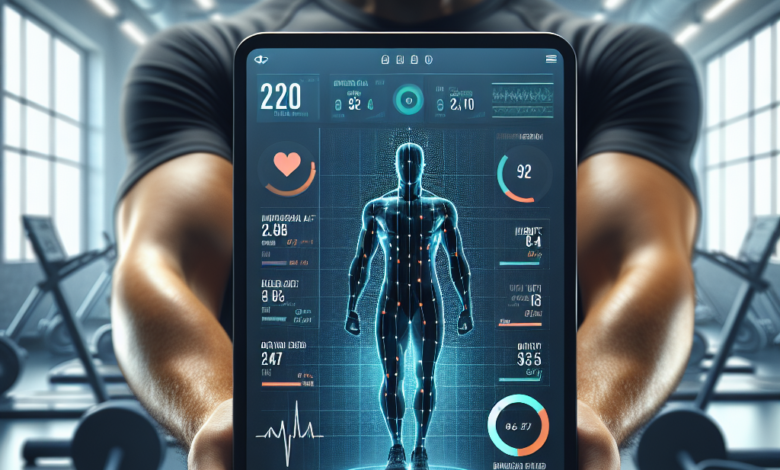Developing a Fitness Profile: Using Data to Get Fit!

The journey to peak fitness is as much about smart training as it is about hard work. In today’s digital age, a fitness profile is developed by using a blend of personal health metrics and advanced data analytics to craft personalized workout plans. Fitness profiles are comprehensive data-driven snapshots of an individual’s physical capabilities, health history, and fitness goals. As you embark on this journey, Explore More at Muscle Theory for insights and guidance on creating your own fitness profile.
Utilizing data effectively can mean the difference between a stagnant routine and a dynamic path to success. By tracking progress through quantifiable metrics such as heart rate, calories burned, distance covered, and weight lifted, you can gain valuable insights into your performance. This data serves as the foundation for understanding your body’s responses to different exercises and intensity levels, allowing for smarter training decisions. It’s the precision and customization facilitated by this data that enables you to fine-tune your workouts to match your body’s unique needs, ensuring you’re always on the most efficient path to achieving your fitness goals.
As we delve deeper into the topic, we will discover how to collect and interpret fitness data, which metrics are the most telling for your goals, and how to adjust your routines for optimal results. Building a solid fitness profile is a critical step in this process. It’s not just about lifting weights or running miles; it’s about understanding the ‘why’ and ‘how’ behind each workout.
Understanding Data’s Role in Personal Fitness
At the core of any effective fitness regimen is the understanding that each individual’s body responds differently to exercise. This is where data steps in to demystify the unique aspects of personal fitness. By systematically analyzing workout results and physiological responses, individuals can identify patterns and correlations that affect their performance and overall health.
Data collection can range from simple metrics, such as daily step count and weekly exercise frequency, to more complex data points like VO2 max (a measure of cardiovascular endurance) and body composition percentages. Advanced wearable technology and fitness apps have made it easier than ever to gather this information seamlessly throughout the day.
With the collected data, a fitness profile becomes more than just a static document; it evolves into a dynamic tool that reflects your progress. By setting benchmarks and tracking improvements in real-time, data can motivate by illustrating tangible progress and providing feedback that informs future training adjustments. For example, a plateau in weight loss might suggest the need for dietary changes or an increase in exercise intensity.
Moreover, data not only aids in customizing workouts but also plays a crucial role in preventing injury. Overtraining and inadequate recovery can be identified through trends in heart rate variability and workout intensity, allowing you to make proactive adjustments. Understanding data’s role in personal fitness is about harnessing the power of information to achieve a balanced and sustainable approach to health and wellness.
Key Metrics to Include in Your Fitness Profile

Creating a comprehensive fitness profile involves tracking a variety of metrics that offer insight into your overall health and fitness levels. Key metrics to consider include:
- Body Composition: This includes measurements such as body fat percentage, muscle mass, and bone density. These figures provide a clearer picture than weight alone, as they show the quality of weight change over time.
- Cardiovascular Fitness: Metrics like resting heart rate and VO2 max give an indication of heart health and aerobic endurance. Regular monitoring can help to identify improvements or the need for changes in your cardio training.
- Strength Levels: Recording the amount of weight you can lift for different exercises helps to track strength gains. It’s important to note the number of repetitions and sets completed to accurately measure progress.
- Flexibility: While more difficult to quantify, benchmarks such as the reach in a sit-and-reach test can be used to assess and improve flexibility over time.
- Workout Consistency: Keeping track of the frequency, duration, and intensity of workouts will help in creating a balanced training plan and in maintaining steady progress.
- Recovery Time: Noting how long it takes your body to recover after workouts can indicate whether you’re allowing enough rest for muscle repair and growth.
- Nutritional Intake: A detailed food diary including macronutrient ratios can be critical in aligning your diet with fitness goals, whether it’s losing fat, gaining muscle, or improving performance.
Including these key metrics in your fitness profile will provide a holistic view of your health and fitness journey. With a focus on both quantitative and qualitative data, you can develop a personalized and effective fitness plan.
Leveraging Wearable Tech for Enhanced Fitness Tracking

Wearable technology has revolutionized the way a fitness profile is developed by using sophisticated tracking capabilities to provide real-time data. Devices such as fitness trackers, smartwatches, and heart rate monitors can continuously collect vital fitness information that can be effortlessly integrated into your fitness profile. Here’s how leveraging wearable tech can enhance your fitness tracking:
- Real-Time Data Collection: Wearable devices monitor physical activity, steps taken, calories burned, and even sleep patterns throughout the day and night, ensuring an ongoing record of your fitness levels.
- Heart Rate Monitoring: By keeping tabs on your heart rate zones during exercise, wearable tech helps tailor your workouts for optimal fat burning and endurance training.
- GPS Tracking: For runners and cyclists, GPS-enabled devices provide detailed information about speed, distance, and routes, which can be invaluable for tracking performance improvements over time.
- Progress Analysis: Many wearable devices come with companion apps that analyze the collected data, making it easier to identify trends, set goals, and measure progress against them.
- Personal Accountability: The presence of a wearable device serves as a constant reminder of your fitness goals, encouraging more activity and mindfulness about health throughout the day.
For those serious about fine-tuning their fitness profile, wearable tech offers a convenient and precise method to gather the necessary data to make informed decisions about health and workout regimens. As technology continues to advance, the integration of these devices into our daily lives provides an unparalleled opportunity for personalized health and fitness management.
Analyzing Your Fitness Data to Tailor Your Routine

The crux of creating an effective and personalized workout plan lies in the ability to analyze the data collected from various sources, including wearable tech. Once a fitness profile is developed by using this data, it becomes possible to refine your exercise routine to better suit your body’s needs and your fitness objectives. Here’s how you can analyze your fitness data:
- Identify Patterns: Look for trends in your data that indicate what times of day you’re most active or what exercises yield the best results. This can help you optimize your workout schedule and routine.
- Set Realistic Goals: Use historical data to set achievable targets. For instance, if you’ve been steadily increasing your running distance, you might set a goal to run a half-marathon after a few months of training.
- Monitor Recovery: Pay attention to how your body recovers post-workout. If certain activities lead to prolonged recovery times, consider adjusting the intensity or frequency to prevent overtraining.
- Benchmark Against Goals: Regularly compare your performance data against your set goals to monitor progress. This helps in maintaining motivation and adjusting goals as needed.
- Customize Workouts: With detailed insights into your strengths and weaknesses, tailor your fitness routine to focus on areas that need improvement, while continuing to challenge and enhance your strengths.
Through diligent analysis of fitness data, you can craft a routine that is uniquely suited to your physiology and goals. This methodical approach not only maximizes the effectiveness of your workouts but also accelerates progress towards your desired fitness outcomes. By continuously evaluating and refining your approach based on the data, you ensure that your fitness journey is guided by the most personalized and up-to-date information available.
Transforming Data into Actionable Fitness Goals

Once you’ve scrutinized your fitness data, the next step is to transform this wealth of information into actionable fitness goals. Data-driven goals are not just numbers; they are the stepping stones to your success. Here’s how to make this transformation:
- Specificity: Your goals should be as specific as possible. Instead of aiming to ‘get fit,’ set a goal to ‘increase running endurance to 5 miles without stopping’ or ‘achieve a 200-pound bench press.’
- Measurability: Ensure that your goals can be measured. Use data from your fitness tracker to quantify progress, such as improving your time, increasing weight, or enhancing endurance.
- Attainability: While ambition is key, your goals should be realistic and attainable. Review your data to set benchmarks that are challenging yet within reach.
- Relevance: Each goal should be relevant to your larger fitness aspirations. If you’re training for a triathlon, your goals should reflect the necessary swimming, cycling, and running proficiencies.
- Time-bound: Give yourself a deadline. Whether it’s weeks, months, or years, a time frame creates urgency and helps maintain focus.
By converting your fitness data into clear, structured goals, you give purpose to every workout and every drop of sweat. Remember, each piece of data tells a story about your body — it’s up to you to listen and adapt. Don’t let your efforts be in vain; use your data to drive you forward, to push boundaries, and to shatter your personal records. When in doubt, remember to Explore More at Muscle Theory for the latest tips and tricks on how to leverage your fitness data to maximize your potential.
Ready to take your fitness journey to the next level by harnessing the power of data? Explore More at Muscle Theory and discover how a little information can lead to monumental gains.



